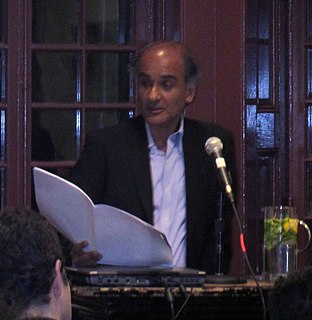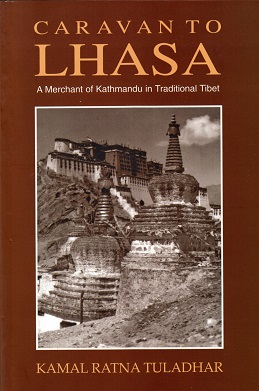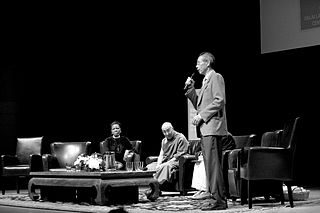
Dalai Lama is a title given by the Tibetan people to the foremost spiritual leader of the Gelug or "Yellow Hat" school of Tibetan Buddhism, the newest and most dominant of the four major schools of Tibetan Buddhism. The 14th and current Dalai Lama is Tenzin Gyatso, who lives as a refugee in India. The Dalai Lama is also considered to be the successor in a line of tulkus who are believed to be incarnations of Avalokiteśvara, the Bodhisattva of Compassion.

Tibet is a region in East Asia, covering much of the Tibetan Plateau and spanning about 2,500,000 km2 (970,000 sq mi). It is the traditional homeland of the Tibetan people as well as some other ethnic groups such as Monpa, Tamang, Qiang, Sherpa and Lhoba peoples and is now also home to considerable numbers of Han Chinese and Hui people settlers. Tibet is the highest region on Earth, with an average elevation of 4,380 m (14,000 ft). Located in the Himalayas, the highest elevation in Tibet is Mount Everest, Earth's highest mountain, rising 8,848.86 m (29,032 ft) above sea level.

The Central Tibetan Administration, often referred to as the Tibetan Government-in-Exile, is a non-profit political organization based in Dharamshala, India. Its organization is modeled after an elective parliamentary government, composed of a judiciary branch, a legislative branch, and an executive branch.

Siddharth Pico Raghavan Iyer, known as Pico Iyer, is a British-born essayist and novelist known chiefly for his travel writing. He is the author of numerous books on crossing cultures including Video Night in Kathmandu, The Lady and the Monk and The Global Soul. He has been a contributor to Time,Harper's, The New York Review of Books, and The New York Times.

Ngawang Lobsang Thupten Gyatso Jigdral Chokley Namgyal, abbreviated to Thubten Gyatso was the 13th Dalai Lama of Tibet, enthroned during a turbulent era and the collapse of the Qing Empire. Referred to as "the Great Thirteenth", he is also known for redeclaring Tibet's national independence, and for his reform and modernization initiatives.

Gedun Gyatso, also Gendun Gyatso Palzangpo, was considered posthumously to have been the second Dalai Lama.

Ngawang Lobsang Gyatso was the 5th Dalai Lama and the first Dalai Lama to wield effective temporal and spiritual power over all Tibet. He is often referred to simply as the Great Fifth, being a key religious and temporal leader of Tibetan Buddhism and Tibet. Gyatso is credited with unifying all Tibet under the Ganden Phodrang after a Mongol military intervention which ended a protracted era of civil wars. As an independent head of state, he established relations with the Qing empire and other regional countries and also met early European explorers. Gyatso also wrote 24 volumes' worth of scholarly and religious works on a wide range of subjects.

Mikel Dunham is an author, artist, photojournalist. and Himalayan historian. In the 1980s, Dunham worked in New York City where he created three-dimensional constructions of wood, glass, mirror, photographs and acrylic media. The Alexander F. Milliken Gallery, Inc. represented his work. mounting numerous solo exhibitions in Soho, as well as group installations in the US and abroad.

Patrick French is a British writer, historian and academician. He was educated at the University of Edinburgh where he studied English and American literature, and received a PhD in South Asian Studies. He was appointed as the inaugural Dean of the School of Arts and Sciences at Ahmedabad University in July 2017.

Tibet came under the control of People's Republic of China (PRC) after the Government of Tibet signed the Seventeen Point Agreement which the 14th Dalai Lama ratified on 24 October 1951, but later repudiated on the grounds that he rendered his approval for the agreement while under duress. This occurred after attempts by the Tibetan Government to gain international recognition, efforts to modernize its military, negotiations between the Government of Tibet and the PRC, and a military conflict in the Chamdo area of western Kham in October 1950. The series of events came to be called the "Peaceful Liberation of Tibet" by the Chinese government, and the "Chinese invasion of Tibet" by the Central Tibetan Administration and the Tibetan diaspora.

Tibetan Uprising Day, observed on March 10, commemorates the 1959 Tibetan uprising against the presence of the People's Republic of China in Tibet. The failure of the armed rebellion ultimately resulted in a violent crackdown on Tibetan independence movements, and the flight of the Dalai Lama Tenzin Gyatso into exile.

Elliot Sperling was one of the world's leading historians of Tibet and Tibetan-Chinese relations, and a MacArthur Fellow. He spent most of his scholarly career as an associate professor at Indiana University's Department of Central Eurasian Studies, with seven years as the department's chair.
The serfdom in Tibet controversy is a prolonged public disagreement over the extent and nature of serfdom in Tibet prior to the annexation of Tibet into the People's Republic of China (PRC) in 1951. The debate is political in nature, with some arguing that the ultimate goal on the Chinese side is to legitimize Chinese control of the territory now known as the Tibet Autonomous Region or Xizang Autonomous Region, and others arguing that the ultimate goal on the Western side is to weaken or undermine the Chinese state. The argument is that Tibetan culture, government, and society were barbaric prior to the PRC takeover of Tibet and that this only changed due to PRC policy in the region. The pro-Tibetan independence movement argument is that this is a misrepresentation of history created as a political tool in order to justify the Sinicization of Tibet.

The 14th Dalai Lama, known as Gyalwa Rinpoche to the Tibetan people, is the current Dalai Lama. He is the highest spiritual leader and former head of state of Tibet. He was born on 6 July 1935, or in the Tibetan calendar, in the Wood-Pig Year, 5th month, 5th day. He is considered a living Bodhisattva, specifically, an emanation of Avalokiteśvara in Sanskrit and Chenrezig in Tibetan. He is also the leader and a monk of the Gelug school, the newest school of Tibetan Buddhism, formally headed by the Ganden Tripa. The central government of Tibet, the Ganden Phodrang, invested the Dalai Lama with temporal duties until his exile in 1959.
The Open Road: The Global Journey of the Fourteenth Dalai Lama is a 2008 book by Pico Iyer.

The Battle of Chamdo occurred from 6 to 24 October 1950. It was a military campaign by the People's Republic of China (PRC) to take the Chamdo Region from a de facto independent Tibetan state. The campaign resulted in the capture of Chamdo and the annexation of Tibet by the People's Republic of China.

Caravan to Lhasa is a travel book and an account of the lives of expatriate Nepalese merchants in Lhasa from the 1920s to the 1960s. Written by Kamal Ratna Tuladhar, the book describes the caravan journey from Kathmandu across the Himalaya, and the life and times of the Newar traders in Tibet through the experiences of his merchant father Karuna Ratna Tuladhar (1920-2008) and uncles.

Gyalo Thondup, born c.1927, is the second-eldest brother of the 14th Dalai Lama. He often acted as the Dalai Lama's unofficial envoy.

Victor Chan is a physicist and a Hong-Kong-born Canadian writer. Founder of the Dalai Lama Center for Peace and Education, Chan has known the 14th Dalai Lama since 1972. Co-author with him of two essays, he also wrote a guide of pilgrimage to Tibet. He lives in Vancouver in British Columbia, Canada.

Thomas C. Laird is an American journalist, writer, and photographer who specializes in Tibet.


















